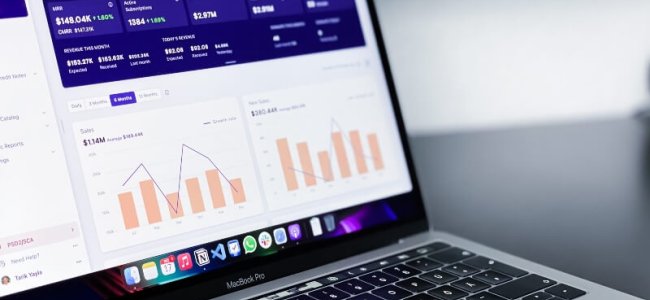Gone are the days when businesses could rely solely on instinct and hearsay for success. Today, strategic business decision-making requires a data-driven approach. That includes leveraging customer insights, planning website changes, and tracking market trends more effectively than ever. To get the most out of your web presence and make intelligent decisions in real-time, you need to master web analytics. Understanding what it is and how to apply it can unlock technical performance benefits like increased conversions, leads, and sales – so let’s dive right into learning about web analytics and ways to start measuring data.
How Do Web Analytics Work
So you've worked tirelessly to create the perfect website, planned out content, and possibly even spent money on online ads. However, these components are just the beginning of what you'll need to expand your website. The next step is looking at your website's analytics, more accurately, your user data. That said, even though it is helpful to have detailed information on user interactions with your site, you may be curious about the means of collection and whether or not they are intrusive.
You can relax knowing your users' personal information is safe on your site. Still, there is a variety of tracking technologies that can give site administrators insight into their users' journeys. Tags' primary function in web analytics systems is to count the times a page is visited, or a button is clicked. This way, you can track how often people have visited different sections of your site without jeopardizing their privacy.
Key Web Analytics Metrics
Measuring data to understand website performance better can be a daunting task. Knowing which metrics to look at is critical. The essential web analytics metrics to measure are:
- Page views: the number of pages users view when they visit a website.
- Bounce rate: the percentage of visitors who visit only one page on a website before leaving it.
- Average session duration: the time users spend browsing and interacting with a website during each visit.
- Conversion rate: the percentage of visits that turn into actual purchases or leads.
Additionally, knowing user demographics such as age, gender, and geographical location can help you better target your audience with tailored campaigns that will increase effectiveness and enhance results over time. Analyzing these essential metrics will help you understand how successful your website is and how changes in strategy may benefit overall site performance.
Selecting the Right Web Analytics Tool
Selecting the right web analytics tool is a crucial decision when measuring data. With the right tools, you can enhance website performance, leads, sales, conversions, and inbound and outbound marketing. There are some excellent options for businesses looking to take that first step into analyzing their website’s metrics. That includes Google Analytics, Adobe Analytics, and Mixpanel. All of these tools offer comprehensive analysis features. When investigating a tool for yourself, consider the kind of insights you're looking for since each tool will have its strengths in terms of reporting capabilities. Additionally, ensure that the platform can successfully adapt and scale with your business as it grows and evolves. Choosing the right web analytics tool is key in optimizing website conversions and ensuring you get the most out of your resources.
Defining Your Goals and KPIs
Web analytics can help you to understand and improve your website performance. Therefore, defining clear objectives, goals, and key performance indicators (KPIs) is essential to ensure the maximum benefit of web analytics efforts. Establishing measurable KPIs that align with your overall business goals will provide valuable insights into the effectiveness of your website. Your defined objectives and KPIs should be specific, timely, and achievable for them to be effective. Language such as “increase” or “improve” must be supported by a target percentage or other specific objective to make them measurable.
Once you have set your goals, select a web analytics tool to measure progress toward achieving them by tracking, reporting, and analyzing real-time data. That will enable you to evaluate your website's performance and tighten any weak spots. So, setting clear, measurable goals for your website is the key to improving website performance, enhancing customer experience that leads to conversions, and increasing sales.
Analyzing and Interpreting Data
Understanding user behavior and trends is vital to developing an effective web analytics strategy. With the right tool, businesses can track how visitors interact with their websites and make informed decisions based on collected data. Analyzing and interpreting the data you gather from web analytics provides valuable insights into how visitors engage with a website. That will enable you to see where to improve and take the proper steps toward achieving your business goals. That said, you have to identify user behavior patterns to analyze customer needs more accurately and effectively tailor the customer experience.
Continuously Monitoring and Improving
It is essential to regularly monitor web analytics data to gain valuable insight into the performance of your website. Regular readings and data interpretation lead to more informed decisions regarding user experience, content optimization, marketing campaigns, and other initiatives. By better understanding how users interact with your website, you can make better decisions on optimizing, tweaking, and improving user experience. That will allow you to deliver better results in everything you do consistently.
Conclusion
Now that you understand web analytics and ways to start measuring data, you should have everything you need to set your website up for success. With the knowledge of where your website is falling short—and where it’s succeeding—you can take actionable steps to optimize it for success. Therefore, if you've not implemented a strategy for measuring web analytics, now is the perfect time to do it.
Guest Post By: Alex Thompson
Alex Thompson is a digital marketing expert and data-driven strategist with over ten years of experience in web analytics and online business growth. By creating content for AZ Citation Services, Alex has helped countless businesses transform their online presence through actionable insights and data-driven decision-making.





